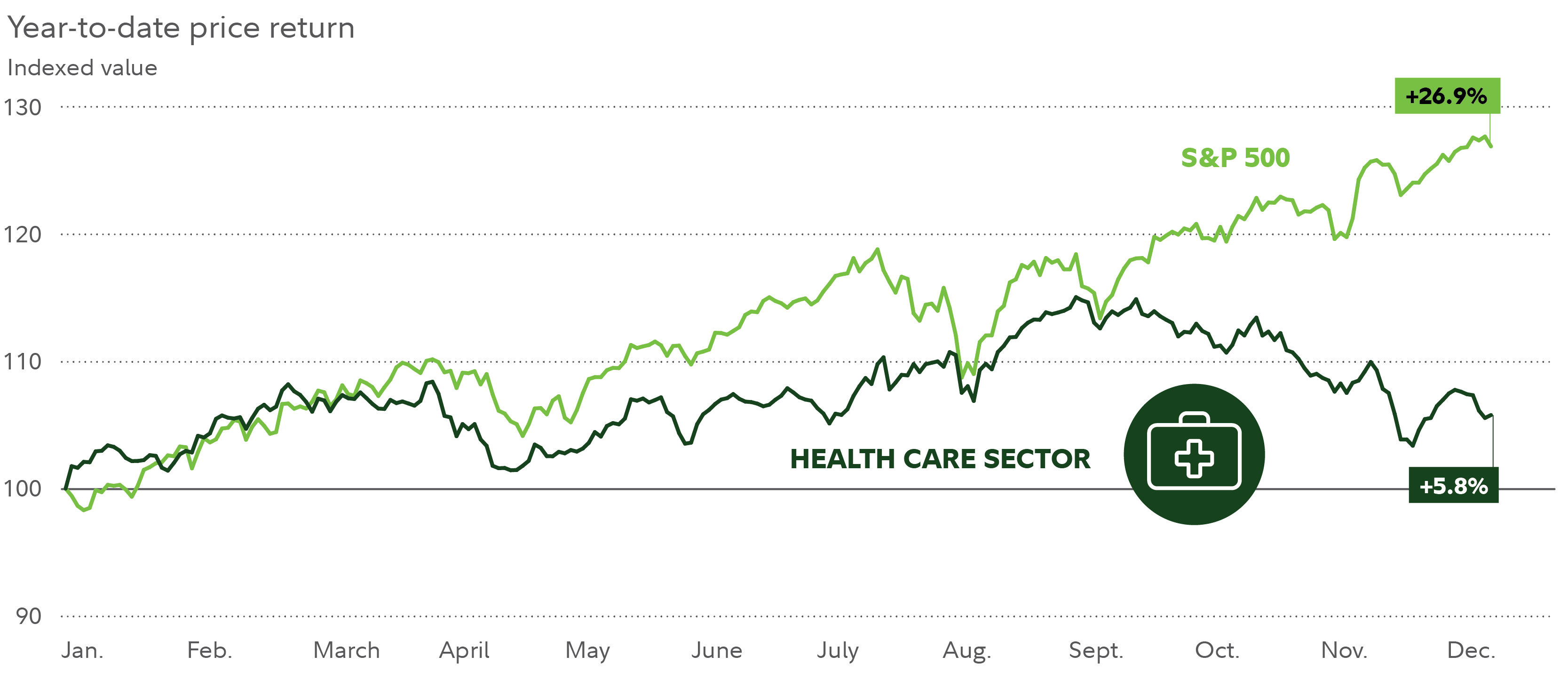Health care stocks had a bumpy year in 2024. The sector was outshined by high-growth megatrends like artificial intelligence (AI). Fundamental challenges and policy uncertainties also posed headwinds for certain health care segments. Some of these policy headwinds may abate with the upcoming change in administration, while others like drug pricing may persist.
Regardless, the future looks potentially bright for health care stocks, many of which have been prolifically innovating in recent years as investors’ attention has been focused elsewhere. And the upside to multiple years of sluggish performance is that valuations across the sector have recently looked quite attractive, offering a potential entry point to a sector with profound long-term drivers.
2024: Coming off a challenging year
In the first half of 2024, health care stocks took a backseat to sectors like technology and communication services, where investors flocked to stocks that offer a potential play on the future of AI. Although returns for health care stocks began to improve in the second half of the year as the market rally broadened, some health care segments struggled as the sector continued to work through supply-and-demand imbalances left over from the pandemic.

Specifically, Americans have still been catching up on surgeries and treatments that they delayed during the pandemic—and so sought services in hospitals, doctor offices, and ambulatory care centers in increased numbers. While this increase in utilization was a benefit for some parts of the sector, like health care facilities and medical-device makers, it weighed heavily on the stocks of managed-care health insurers. Also, life sciences tools and services companies, the segment of the sector that focuses on testing and analysis, saw declining demand as people used fewer COVID tests and continued to work down pandemic-related inventory buildups.
Policy posed another headwind. Health insurers that administer Medicare Advantage policies, a type of Medicare health plan offered by a private company that contracts with Medicare, were hit by inadequate reimbursement rates (i.e., the payments the federal government makes to these insurers). And policy uncertainty inherent in an election year likely weighed on the sector as a whole.
On the upside, innovation continued at a strong pace. Biotech companies made a series of positive clinical announcements. And excitement around new obesity and diabetes treatments helped turn Eli Lilly (
2025: Innovation and improvement lead the way
For 2025 and beyond, I believe many health care industries may be well positioned.
Some headwinds that held the stocks back in the past year may be poised to fade. For example, the unexpected acceleration in utilization is likely to eventually reverse. Any indication that we’ve reached the peak of utilization could be positive for the performance of managed-care providers. And the conclusion of election season should dampen policy fears surrounding the sector. The incoming administration could favor policies that are more advantageous for the sector—particularly for managed care companies—such as by allowing for greater flexibility over Medicare Advantage policy prices and risk coding, and by potentially pausing or even reversing some of the previous administration’s policies.
Moreover, I’ve been seeing a lot of green shoots in terms of novel, viable drug candidates in biotechnology, which gives me optimism about the growth prospects for this innovative sector.
Fund top holdings2
Top-10 holdings of the Fidelity® Select Health Care Portfolio (
- 11.0% – UnitedHealth Group Inc. (
- 9.7% – Boston Scientific Corp. (
- 6.9% – Eli Lilly & Co. (
- 6.1% – Danaher Corp. (
- 4.1% – Penumbra Inc. (
- 3.0% – Insulet Corp. (
- 2.6% – Stryker Corp. (
- 2.6% – Masimo Corp. (
- 2.5% – Regeneron Pharmaceuticals Inc. (
- 2.2% – argenx SE (
(See the most recent fund information.)
Potential value in specialty drugmakers
Anti-obesity drugs may have taken center stage in recent years, but recent dramatic breakthroughs in the biotechnology industry could be game changers in the coming years. Overall, biotech firms have been supported by a decrease in the cost of genome sequencing, the expansion of cell-based therapies, and an accelerated pace of drug discovery. Just this year, biotech firms have been reporting encouraging clinical data in blockbuster categories that could move the needle for industry sales. In particular, so-called specialty drugs, which typically are new drug categories that start at higher price points, have recently seen sales expanding by 15% to 17% a year.
Alnylam Pharmaceuticals (
A potential entry point
While health care lagged in 2024, low current valuations could provide an opportunity for investors who want exposure to a sector with strong long-term drivers—chief among them an aging US population increasingly in need of medical care.
The sector also sports improving business fundamentals, like cash flows, and a vast and diverse number of industries with a combination of defensive and growth characteristics that may be attractive in a variety of scenarios.

Edward (Eddie) Yoon is a sector leader and portfolio manager in the Equity division at Fidelity Investments. Fidelity Investments is a leading provider of investment management, retirement planning, portfolio guidance, brokerage, benefits outsourcing, and other financial products and services to institutions, financial intermediaries, and individuals.
In this role, Mr. Yoon is responsible for the coverage of health care equipment and supplies stocks, and serves as the health care sector leader. Additionally, he manages several funds including Fidelity Advisor Health Care Fund, Fidelity and Fidelity Advisor Stock Selector Mid Cap Fund, Fidelity and Fidelity Advisor All Cap Fund, Fidelity Select Health Care Portfolio, and Fidelity Select Medical Technology and Devices Portfolio.
Prior to joining Fidelity in 2006, Mr. Yoon worked on the health care team at JPMorgan Asset Management. He has been in the financial industry since 2002.
Mr. Yoon earned his bachelor of arts degree in business economics from Brown University.



